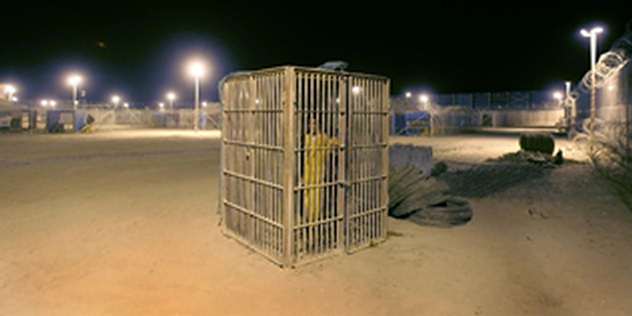By Sanya Mansoor
The plaintiffs accuse Virginia-based CACI, which was hired by the US government to provide interrogation services, of contributing to the torture of detainees at the Iraqi prison. The trial is expected to last for four to five days.
Following 16 years of legal wrangling -and more than 20 attempts by CACI to dismiss the case- the new trial began before the US District Court for the Eastern District of Virginia on Wednesday, picking up the case a judge declared a mistrial in April; the jury was deadlocked after more than a week of deliberations.
Disturbing images of smiling American soldiers posing next to abused detainees at Abu Ghraib shocked the world in the mid-2000s, but April’s proceedings marked the first time that an American jury directly heard claims brought by people held at the notorious prison.
The three Iraqi men -a journalist, a middle school principal, and a fruit vendor- spoke in court via video conference earlier this year about their experience being threatened with dogs, subjected to electric shocks, and stripped of their clothing.
Asa’ad Hamza Hanfoosh Al-Zuba’e, who was imprisoned at Abu Ghraib from 2003 until 2004, said that he believed people who undressed him and touched his genitals were civilian officers based on their clothing. “I was heavily embarrassed. I was crying, I was screaming,” he told the jury. Al-Zuba’e also accused civilian officers of threatening to rape his wife.
It’s rare for people who sued the US government over human rights violations tied to its “war on terror” to get a trial, as the Supreme Court has set precedent that makes it easier for the government to squash cases over alleged national security concerns.
“CACI has raised every legal challenge imaginable,” says Shirin Sinnar, a law professor at Stanford University. “The procedural hurdles are often what kill cases. Most people who have powerful claims about suffering torture never actually get their day in court.”
The plaintiffs, represented by the Center for Constitutional Rights, filed a lawsuit in 2008 under the Alien Tort Statute. This law allows noncitizens to bring cases involving clear violations of international law, such as torture, to an American federal court when there’s a substantial connection to the US.
Even though the Supreme Court has narrowed the scope of this law multiple times, the case against CACI has survived. In 2018, Judge Leonie Brinkema found plaintiffs had enough evidence to allow the case to proceed to a trial. Sinnar notes that Brinkema doesn’t always take the plaintiff’s side in these kinds of cases, but she has also ruled against the government when it puts forward national security claims. “She’s been willing to question that,” she says. “That may be significant here.”
CACI has relied on a “borrowed servant” defense to suggest that the US military oversaw the interrogators’ conduct and is ultimately responsible for conduct at Abu Ghraib. The defense contractor has also argued there’s no definitive evidence CACI personnel abused the three Iraqi men -and that it could have been American soldiers carrying out the abuses.
The plaintiffs argue that even if this were the case, civilian interrogators from CACI participated in a conspiracy with soldiers to abuse detainees as a way to “soften them up” for questioning.
They rely, in part, on a 2004 report by Army Major Gen. Antonio Taguba on allegations of detainee abuse at Abu Ghraib; Taguba identified “numerous incidents of sadistic, blatant, and wanton criminal abuses” in 2003, and specifically noted that military intelligence and CACI interrogators instructed military police to “set the conditions” for detainees’ interrogations.
In Wednesday’s opening statements, both sides argued over who was responsible for the contractors’ conduct: the Army or CACI. A lawyer with the Center for Constitutional Rights alleged that CACI “turned a blind eye” to its employees’ misconduct in order to protect a $31 million contract with the US government. A representative for CACI stressed that the army controlled every aspect of CACI interrogators’ work.
Stjepan Meštrović, a sociology professor at Texas A&M University and expert witness in multiple courts-martial of soldiers who served at Abu Ghraib, notes that determining responsibility is difficult because the prison’s leadership did not have a traditional structure.
“There was no one chain of command,” he says. “No one knows where the civilian contractors fall in the command structure. That is the legal problem.”
Leaving aside the question of who made the decisions at Abu Ghraib, civilian contractors should still be held responsible for their conduct, says Sinnar: “You can’t just say you were following orders, when it’s something that anyone should know is immoral and unlawful.”
This is not the first time a defense contractor has been sued in connection with their work at Abu Ghraib. In 2013, Englity, formerly known as L-3 Services Inc., paid more than $5 million in a settlement to 71 former inmates held at Abu Ghraib and other US-run detention sites in Iraq.
Meštrović stresses that the focus on civilian contractors only constitutes a small part of what occurred at Abu Ghraib.
“There were scores of officers, and others, who were involved and did not get punished,” he says. “They only punished the so-called few rotten apples. They didn’t go after the apple orchard.” Only about a dozen American soldiers were convicted in connection with detainee abuse at Abu Ghraib.
A Senate report released in 2008 suggested that the responsibility went as high as former Defense Secretary Donald Rumsfeld and other senior US officials.
Still, Al Shimari v. CACI could provide some degree of accountability. Suhail Najim Abdullah Al Shimari, who was detained for a month in 2003, said in April’s trial that he was choked and beaten so badly that he lost teeth. He still suffers from headaches and hallucinates -and claims this didn’t happen prior to his stay at Abu Ghraib.
Even though two decades have passed since the harm faced by plaintiffs, “it’s not like these things go away,” says Sinnar. “Getting that kind of acknowledgment in a court decision can help with people’s healing.”





